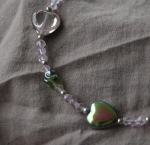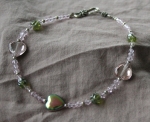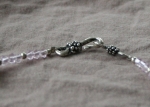Okay, I wasn’t planning on writing anything about photography itself, but I keep getting asked. Here are the tips that made my photography improve so dramatically that an Etsy admin told me she was in tears and put one of my items in a gift guide.
I’m not getting into the minutiae of tweaking your camera’s settings, since every camera is different. Everything I list here is something you can probably do with any modern digital camera, even the cheap point-and-shoot ones. Look up the various modes and features in your camera’s manual (and remember that if you don’t have the manual, the camera manufacturer may have it online).
1) Use a tripod. Holding onto the camera makes it shake, and that shake can be picked up as blurriness in the finished picture. Even cheap cameras have a threaded hole on the bottom for a tripod, and tripods themselves are cheap — if you don’t want to go all-out on an expensive Manfrotto or something, go to a big-box electronics store and buy a little tabletop tripod for under $20.
2) Use the timer setting. Again, even cheap point-and-shoot cameras often have a timer, since a lot of people like to set up a picture and then run to be in it. In the case of product photography, this is one more thing that will let you take a picture without touching the camera and introducing shake. The timer setting is usually indicated by a little clock icon.
3) Use natural lighting. Lightboxes are neat, but they really just try to emulate the indirectness and colourlessness of natural light. If you have a room with windows, open all the curtains wide and set up your item to be photographed so that no sunbeam is falling directly on it. If you think it’s too cloudy or too dark out to take pictures, try it anyways and see what you get. If you find that your ideal lighting doesn’t naturally happen often enough, then build yourself a lightbox. A lightbox or proper natural lighting will let you take pictures without flash, which is a good thing, because flash introduces glare and funny colours.
4) Use the macro setting. Many cameras have preset modes for different kinds of pictures. Macrophotography means closeup shots (think about taking pictures of flowers or bugs), and that’s what you’re probably doing if you’re photographing something like jewelry or toys. Your camera’s preset macro mode is probably indicated by a little icon that looks like a tulip.
5) Choose your background wisely. Avoid complex patterns, because your item will get lost in them. Use solid colours that contrast with the colours of your item, and try to get textures that don’t glare too much (no glossy paper) or that show up imperfections (no fuzzy fabrics with cat hair clinging to them). To get a variety of colours cheap, go to an art store and get a selection of cardstock or fancy paper, or go to a fabric store and buy a yard each of different colours of cheap cotton broadcloth.







